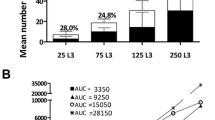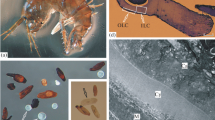Abstract
Adult filariae of two intranodularOnchocerca species of red deer (Cervus elaphus) were examined at the ultrastructural level. In all, 90 nodules ofO. flexuosa and 20 nodules ofO. jakutensis were studied by histology,O. jakutensis caused cystic and pus-filled nodules in which the female and male worms were motile. Female worms possessed a thick cuticle and a well-developed somatic musculature. The basal lamina of the muscular syncytia was connected with the transhypodermal fibers through long protrusions. The epicuticle had only few protuberances and no visible surface coat. FemaleO. flexuosa showed morphological features similar to those of other intranodular filariae. A surface coat could not be detected. In 24% of 33 nodules with young live female worms and 40% of 38 nodules with older live femaleO. flexuosa the worms were surrounded by giant cells apparently attacking a cuticle. This was found even in nodules obtained from animals no older than 9 months. It is probable that the lack of a surface coat protecting the female worm and the inability to move due to the reduced somatic muscles lead to an early elimination ofO. flexuosa by the host's immune system.
Similar content being viewed by others
References
Bain O, Schulz-Key H (1974) Les onchocerques du cerf européen: redescription d'O. flexuosa (Wedl, 1856) et description d'O. tubingensis n. sp. etO. tarsicola n. sp. Trop Med Parasitol 25: 437–449
Blaxter ML, Page AP, Rudin P, Maizels RM (1992) Nematode surface coats: actively evading immunity. Parasitol Today 8:243–247
Büttner DW, Albiez EJ, Essen J von, Erichsen J (1988) Histological examination of adultOnchocerca volvulus and comparison with the collagenase technique. Trop Med Parasitol 39:390–417
Callahan HL, Crouch RK, James ER (1988) Helminth antioxidant enzymes: a protective mechanism against host oxidants. Parasitol Today 4:218–225
Callahan HL, Hazen-Martin D, Crouch RK, James ER (1993) Immunolocalization of superoxide dismutase inDirofilaria immitis adult worms. Infect Immun 61:1157–1163
Deardorff TL, Jones RE, Kayes SG (1991) Adherence of eosinophils to the epicuticle of infective juveniles ofAnisakis simplex (Nematoda, Anisakidae). Proc Helminthol Soc Wash 58:132–137
Demiaszkiewicz AW (1993) Redescription ofOnchocerca jakutensis (Gubanov, 1964) (Nematoda, Filaroideae). Acta Parasitol Pol 38:124–127
Dykova I, Blazek K (1972) Subcutaneous filariasis in red deer. Acta Vet (Brno) 41:117–124
Edwards MK, Busto P, James ER, Carlow CKS, Philipp M (1990) Antigenic and dynamic properties of the surface ofOnchocerca microfilariae. Trop Med Parasitol 41:174–180
Franz M (1980) Electron microscopic study of the cuticle of male and femaleOnchocerca volvulus from various geographic areas. Trop Med Parasitol 31:149–164
Franz M (1982a) The fine structure of adultOnchocerca volvulus. I. The cuticle, the hypodermis and the muscle cells of the male worm. Trop Med Parasitol 33:69–75
Franz M (1982b) The fine structure of adultOnchocerca volvulus. II. The intestine and the reproductive system of the male worm. Trop Med Parasitol 33:169–174
Franz M (1988) The morphology of adultOnchocerca volvulus based on electron microscopy. Trop Med Parasitol 39:359–366
Franz M, Andrews P (1986) Fine structure ofLitosomoides carinii (Nematoda, Filaroidea). Z Parasitenkd 72:387–395
Franz M, Büttner DW (1983a) The fine structure of adultOnchocerca volvulus. III. The cuticle, the interchordal hypodermis and the muscle cells of the female worm. Trop Med Parasitol 34:61–69
Franz M, Büttner DW (1983b) The fine structure of adultOnchocerca volvulus. VI. The hypodermal chords of the female worm. Trop Med Parasitol 34:122–128
Franz M, Büttner DW (1983c) The fine structure of adultOnchocerca volvulus. V. The digestive tract and the reproductive system of the female worm. Trop Med Parasitol 34:155–161
Franz M, Copeman DB (1988) The fine structure of male and femaleOnchocerca gibsoni. Trop Med Parasitol 39:466–468
Franz M, Melles J, Büttner DW (1984) Electron microscope study of the body wall and the gut of adultLoa loa. Z Parasitenkd 70:525–536
Franz M, Schulz-Key H, Copeman DB (1987) Electron microscopic observations on the female worms of sixOnchocerca species from cattle and red deer. Z Parasitenkd 74:73–83
Frenkel JK, Taraschewski H, Voigt WP (1988) Important pathological effe ts of parasitic infections of man. In: Mehlhorn H (ed) Parasitology in focus. Springer, Berlin Heidelberg New York, pp 221–311
Jürgens S, Schulz-Key H (1990) Effect of ivermectin on the vertical distribution ofOnchocerca volvulus microfilariae in the skin. Trop Med Parasitol 41:165–168
Maizels RM, Denham DA (1992) Diethylcarbamazine (DEC): immunopharmalogical interactions of an anti-filarial drug. Parasitology 105:49–60
McLaren D (1980) Ultrastructural studies of eosinophils and their interaction with parasites. Trans R Soc Trop Med Hyg 74 [Suppl]:268–337
Mehlhorn H, Dubremetz JF, Franz M, Gustafsson M, Peters W, Taraschewski H, Walldorf V, Voigt WP (1988) Morphology of metazoan organization. In: Mehlhorn H (ed) Parasitology in focus. Springer, Berlin Heidelberg New York, pp 221–311
Nitisuwirjo S, Ladds PW (1980) A quantitative histopathological study ofOnchocerca gibsoni nodules in cattle. Trop Med Parasitol 31:467–474
Parsons JM, Bowman DD, Grieve RB (1986) Tissue localization of excretory-secretory antigens of larvalToxocara canis in acute and chronic murine toxocariasis. Am J Trop Med Hyg 35:974–981
Schulz-Key H (1988) The collagenase technique: how to isolate and examine adultOnchocerca volvulus for the evaluation of drug effects. Trop Med Parasitol 39:423–440
Smith HV (1991) Immune evasion and immunopathology inToxocara canis infection. In: Kennedy MW (ed) Parasitic nematodes—antigens, membranes and genes. Taylor and Francis, London, pp 116–139
Smith HV, Quinn R, Kusel JR, Girdwood RW, Abruce RG (1981) The effect of temperature and antimetabolites on antibody binding to the outer surface of second stageToxocara canis larvae. Mol Biochem Parasitol 4:183–193
Vincent AL, Ash LR, Frommes SP (1975) The ultrastructure ofBrugia malayi (Brug 1927) (Nematoda, Filaroidea). J Parasitol 61:499–512
Walter RD, Arias AE, Rathaur S, Diekmann EF (1987) Secretory enzymes fromOnchocerca volvulus during in vitro maintenance. Trop Med Parasitol 38:339
Author information
Authors and Affiliations
Rights and permissions
About this article
Cite this article
Plenge-Bönig, A., Krömer, M. & Büttner, D.W. Light and electron microscopy studies onOnchocerca jakutensis andO. flexuosa of red deer show different host-parasite interactions. Parasitol Res 81, 66–73 (1995). https://doi.org/10.1007/BF00932419
Received:
Accepted:
Issue Date:
DOI: https://doi.org/10.1007/BF00932419




